Whitehall Group
The Whitehall group (or less frequently, Whitehall Circle) is a term applied to a small circle of art connoisseurs, collectors, and patrons, closely associated with King Charles I, who introduced a taste for the Italian old masters to England. The term usually includes the advisors and agents who facilitated the group's acquisition of works of art.
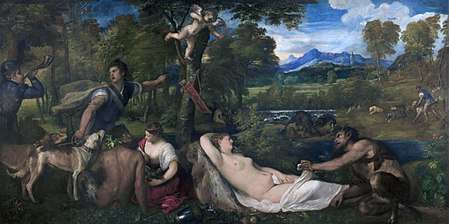
Usage
The term "Whitehall Group" was used by Oliver Millar in a magazine article in 1956 and subsequently in a 1958 book.[1] He used the term "Whitehall Circle" in a book published in 1971.[2] The term encompasses King Charles I himself and a number of his close associates including the Duke of Buckingham, the Earl of Arundel, the 3rd and 4th Earls of Pembroke, the Earl of Northumberland and the Duke of Hamilton. Between them, they introduced a taste for the Italian old masters to England. 16th century Italian paintings were more highly valued than Dutch pictures.[3] Arundel was perhaps the most dedicated connoisseur of the group, whilst Hamilton may have taken an interest in art collecting simply to gain the ear of the King. The group acquired works through a network of advisors, agents, dealers and ambassadors who had a significant influence in the formation of the group's collections.[4] These included William Petty, Sir Dudley Carleton, Balthazar Gerbier and Inigo Jones.
Activities
Following the accession of Charles I, art and collecting became an integral part of life at court.[5] The group were able to exploit the low cost of paintings to accumulate significant collections in a short time.[6] They collected paintings and other works of art including sculptures and tapestries. These were more highly prized than paintings in the 17th century. As far as paintings were concerned, they were primarily interested in acquisition of old masters, but did commission new works by outstanding contemporary artists such as Rubens and van Dyck. Between them they produced what Alex Trumble described as "the most spectacular but short-lived episode in British connoisseurship".[7] As a result of the Group's activities, on the eve of the Civil War, the area of London close to the Strand which included the London homes of most members of the group, contained some of the finest pictures in the world.[8]
Members of the Group
King Charles I

King Charles I was the most passionate and generous collector of art among the British monarchs, and saw art as a way of promoting his grandiose view of the monarchy. His interest in art was initially stimulated by his elder brother, Henry, and his enthusiasm was subsequently encouraged by George Villiers, 1st Duke of Buckingham. One of his first acquisitions was Woman in a fur wrap (right) bought in a Madrid market while he and Buckingham were attempting to secure Charles's marriage to the sister of King Phillip IV.[9] In the space of about twenty years, King Charles put together one of the largest collections of works of art in Europe, relying "on the eyes and ears of a number of agents and connoisseurs".[10] Charles bought extensively from Italy where economic conditions meant that collection owners needed to raise money. In 1628, he bought the fabulous collection that the Gonzagas of Mantua were forced to dispose of. As a result of this, his collection rivalled that of the King of Spain.[11] His interest in art also resulted in him being given works by European rulers attempting to gain favour or as part of marriage negotiations.
Following his accession in 1625 he tried to bring leading foreign painters to England. In 1626, he was able to persuade Orazio Gentileschi to settle in England, later to be joined by his daughter Artemisia and some of his sons. Rubens, who eventually came to London in 1630 on a diplomatic mission, was an especial target. While in London Rubens painted and later supplied more paintings from Antwerp. He was very well-treated during his nine-month visit, during which he was knighted. Charles eventually persuaded Ruben's pupil, Van Dyck, to settle in London.
Charles employed English and foreign court painters from whom he commissioned new works. In addition to Van Dyck, these included Cornelius Johnson and Daniel Mytens. Van Dyck's portraits, particularly those on horseback that disguised the fact that Charles was very short (less than 5 feet (1.5 m) tall), presented an authoritative and majestic image of the King.
Much of his collection was put up for sale during the protectorate. Both Spanish and French collectors were active in obtaining paintings and a number of the best works are now in European collections. However, many of the works that were still in England at the time of the restoration were returned and now form part of the Royal Collection.
Thomas Howard, Earl of Arundel


Thomas, Earl of Arundel (sometimes known as "the collector earl") and his wife Aletheia were dedicated art connoisseurs. They were arguably the greatest collectors in early Stuart England.[10] Thomas had gained some works from the collection of his uncle, Baron Lumley. In 1613, Arundel and his wife paid an extended visit to Italy in the company of Inigo Jones and 34 attendants (among whom was William Petty).[12] In Venice, they were joined by Sir Dudley Carleton who was the ambassador to Venice.
When the Countess inherited a third of her father's estate they were able to pursue their passion for collection. Their activities in collecting statues and paintings was emphasised in a pair of portraits painted by Daniël Mijtens by depicting them in front of their sculpture and picture galleries.
They fled abroad as a result of the Civil War. Their collection was slowly dispersed because of the need to sell to support themselves. When Arundel died, he still possessed 700 paintings, along with large collections of sculpture, books, prints, drawings, and antique jewelry. Most of his collection of marble carvings, known as the Arundel marbles, was eventually left to the University of Oxford. What remained of the collection was sold by their son, following Aletheia's death.
George Villiers, 1st Duke of Buckingham
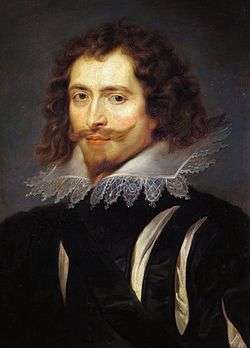
Buckingham was a favourite of both James I and Charles I. He was a great collector of works of art[13] which were on show at York House, his London residence.[14] Buckingham accompanied Charles (then Prince of Wales) to Madrid and saw first hand the Spanish King's art collection. Buckingham employed Balthazar Gerbier to collect paintings for him. Gerbier went to Rome in November 1624, on a buying expedition for him. In 1635, following Buckingham's death, an inventory of his collection was prepared.[15] Subsequently, the collection was sequestrated by Parliament and some works were "embezzled". In due course, parts of the collection were bought by the Earl of Northumberland and Abbot Montague, while other parts were sold at auction in 1758.[16]
William Herbert, 3rd Earl of Pembroke

He was a courtier and important patron of art who held office under both James I and Charles I. Both Ben Jonson and Inigo Jones benefited from his patronage.[17] Herbert appears to have paid for Inigo Jones to tour Italy in 1605.[18]
Philip Herbert, 4th Earl of Pembroke
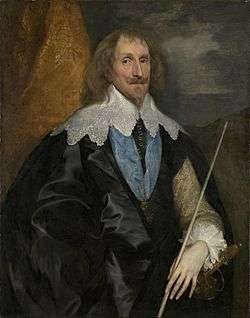
He inherited both the title and art collection on the death of his brother, the 3rd Earl in 1630. According to Aubrey, he "exceedingly loved paintings" and was "the great patron of Sir Anthony van Dyck.[19]
As he supported Parliament in the Civil War, his collection remained more or less intact. It is displayed at Wilton House in Wiltshire. Inigo Jones was involved in the redesign of the house in the 17th century including the single cube room which houses part of the collection.[20]
James Hamilton, Earl of Arran, later 3rd Marquis and 1st Duke of Hamilton
In 1623, Hamilton accompanied his father to join Charles, Prince of Wales and Buckingham in Spain, where he saw for the first time the works of major European artists. Although younger than other members of the group, Hamilton became noted as an art collector.[21] Between 1636 and 1638 he acquired 600 paintings. When he died, many of his paintings went to Antwerp and some can be seen in the background of Views of the Archduke's Picture Gallery by Teniers.[8]
Advisors and agents
Balthazar Gerbier
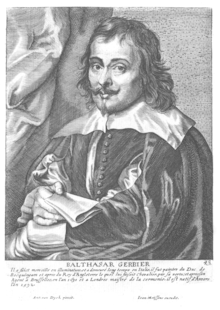
Gerbier accompanied the then Prince of Wales and the Duke of Buckingham on their quixotic visit to Madrid attempting to marry a Spanish princess. Gerbier took the two of them on visits to Spanish royal and noble picture collections, which awakened the interest of Charles in what could be achieved by art.[22] He also accompanied Buckingham to Paris when Charles married Henrietta Maria by proxy. He acted as Buckingham's agent in Italy and the southern Netherlands.[10]
Buckingham provided lodgings for Gerbier at his London residence, York House.[23] Gerbier continued to act on behalf of Buckingham and (after Buckingham's assassination) other members of the Whitehall group. In 1640, he wrote to both the King and the Earl of Arundel announcing the death of Rubens and pointing out the opportunity this provided to acquire fine paintings.
Daniel Nys
Daniel Nys was "a strange, shadowy, Flemish dealer who knew Italy well".[24] In 1621 he facilitated the purchase of Titian's Ecce Homo by Gerbier for the Duke of Buckingham.[25] Nys was involved in a transaction by which a collection of paintings and sculptures went via Sir Dudley Carleton to the Earl of Arundel. Along with Nicholas Lanier, he also acted as agent for Charles I when he acquired the Garganza collection.[10][26]
William Petty
Petty was chaplain to the Earl of Arundel.[27] Arundel trained him in art appreciation and he was with Arundel and Inigo Jones on their 1613 trip to Italy.[28] Petty subsequently worked as an agent for Arundel for many years in Italy, Greece and Asia Minor.[7]
Inigo Jones

Jones was an architect, artist and connoisseur who was employed in the court of Charles I. He exercised the most influence over court culture by organising many Court Masques and incorporating images from the group's collections in their backdrop.[29][10] He accompanied the Arundels on their visit to Italy. In 1628, he was instructed (along with Nicholas Lanier) to put together an inventory of Charles I works of art.[26]
Sir Dudley Carleton (later Viscount Dorchester)
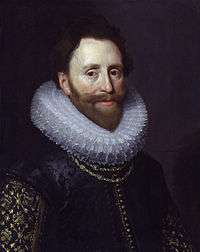
In 1610, Carleton was knighted and sent as ambassador to Venice. He began to look for works of art for Charles (then Duke of York) and other members of the Whitehall group.
In 1616, he was appointed ambassador to the Netherlands. He continued his interests in the art trade, exchanging statues for paintings with Rubens. He served as an intermediary for collectors such as Pembroke, Buckingham and Arundel to whom he sent paintings by Daniel Mytens and Gerard van Honthorst.
Abraham van der Doort

Van der Doort initially worked for Prince Henry and on his death, van der Doort moved in to the service of Charles I. He was Surveyor of the King's Pictures for Charles and maintained an inventory of the King's art collection. The catalogue survives as a complete manuscript and was described by Ellis Waterhouse as "the fullest catalogues of their day in Europe."[30]
Nicholas Lanier
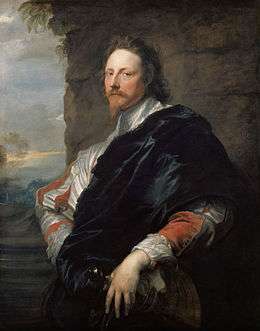
Nicholas Lanier was Master of the King's Music. He went to Italy in 1625, buying paintings on behalf of the King, including working with Daniel Nye to acquire the Gonzaga (Mantuan) collection.[10] He was subsequently instructed (along with Inigo Jones) to put together an inventory of Charles I works of art.[26]
References
- Millar, Oliver (1958). Rubens:the Whitehall Ceiling. Oxford University Press. p. 6.
- Millar, Oliver (1971). Dutch pictures from the royal collection. p. 11.
- Hill, Robert, 2003, Sir Dudley Carleton and his relations with Dutch artists 1616–1632 in Roding, Juliette, Dutch and Flemish Artists in Britain 1550–1800, Primavera, page 271
- Cools, Hans; Keblusek, Marika; NoldusK, Badeloch, eds. (2006). "A Question of Attribution: Art Agents and the Shaping of the Arundel Collection". Your Humble Servant: Agents in Early Modern Europe. Royal Netherlands Institute at Rome. p. 25.
- Rowse, A. L. (1986). Reflections on the Puritan Revolution. Methuen. p. 67.
- Peck, Linda Levy (2005). Consuming Splendor: Society and Culture in Seventeenth-Century England. Cambridge University Press. p. 183.
- "Review in the Times Literary Supplement". the-tls.co.uk. Retrieved 25 January 2019.
- Stourton, James; Sebag-Montefiore, Charles (2012). The British as art collectors. Scala. p. 65.
- Review of Charles I: King and Collector
- Wood, Jeremy; Artists and Agents - Connoisseurship at the Caroline Court; Exhibition catalogue, Royal Society of Arts, 2018
- Stourton, James; Sebag-Montefiore, Charles (2012). The British as art collectors. Scala. p. 62.
- Stourton, James; Sebag-Montefiore, Charles (2012). The British as art collectors. Scala. p. 50.
- "George Villiers (1592-1628), 1st Duke of Buckingham - National Maritime Museum". collections.rmg.co.uk. Retrieved 25 January 2019.
- Bracken and Hill Sir Isaac Wake, Venice and art collecting in early Stuart England
- Jaffé, Michael (1966). "The Picture of the Secretary of Titian". The Burlington Magazine. 108 (756): 120.
- Fairfax, Brian; Walpole, Horace; Talman, John (25 January 2019). "A Catalogue of the curious collection of pictures of George Villiers, Duke of Buckingham : in which is included the valuable collection of Sir Peter Paul Rubens : with the life of George Villiers, Duke of Buckingham, the celebrated poet, written by Brian Fairfax ... : also, a catalogue of Sir Peter Lely's capital collection of pictures, statues, bronzes, &c. with the exact measures of the pictures in both collections : a description of Easton-Neston in Northamptonshire, the seat of the Right Honourable the Earl of Pomfret, with an account of the curious antique statues, busto's, urns, &c. : a description of the cartoons at Hampton-Court : a letter from Mr. I. Talman to Dr. Aldrich ... giving an account of a fine collection of drawings of Monsignor Marchetti, Bishop of Arezzo, collected by the celebrated Father Resta". London : Printed for W. Bathoe ... Retrieved 25 January 2019 – via Internet Archive.
- "William Herbert, 3rd Earl of Pembroke - Person - National Portrait Gallery". www.npg.org.uk. Retrieved 25 January 2019.
- "Oxford Dictionary of National Biography". oxforddnb.com. Retrieved 25 January 2019.
- Aubrey, John (1999). Aubrey's Brief Lives. David R Godine. p. [146].
- "Royal Institute of British Architecture". architecture.com. Retrieved 25 January 2019.
- Tate. "'Portrait of James Hamilton, Earl of Arran, Later 3rd Marquis and 1st Duke of Hamilton, Aged 17', Daniel Mytens the Elder, 1623". Tate. Retrieved 25 January 2019.
- Brown, Jonathan (1995). Kings & Connoisseurs. Yale University Press. p. 35.
- Edward Croft-Murray, "The Landscape Background in Rubens's St. George and the Dragon" The Burlington Magazine for Connoisseurs 89No. 529 (April 1947:89-91, 93) p. 90.
- Stourton, James; Sebag-Montefiore, Charles (2012). The British as art collectors. Scala. p. 61.
- Jaffé, Michael (1966). "The Picture of the Secretary of Titian". The Burlington Magazine. 108 (756): 123.
- Wood, Jeremy; Connoisseurship of the Arts; Weiss Gallery
- Rev. William Petty
- Grove Art Online
- Peacock, John (1995). The Stage Designs of Íñigo Jones. Cambridge University Press. p. 45.
- Waterhouse, reviewing the Walpole Society publication in The Burlington Magazine 103 (June 1961), p. 287.
Further reading
- Brotton, Jerry, The Sale of the Late King's Goods: Charles I and His Art Collection, 2007, Pan Macmillan, ISBN 9780330427098